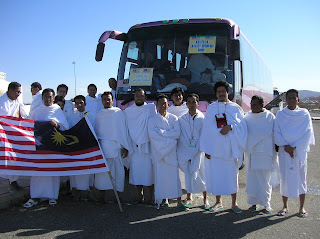
Children Enjoying Ice Cream After the Gruelling Tawaf and Sa'ee

Children None the Worse for Wear and Tear

As Malaysian pilgrims started leaving for the Holy land beginning last week, Papa’s mind constantly wanders off to that singularly absorbing, overwhelming and uplifting experience that happened nearly two years ago. The year 2006 was about to draw its curtain, and Mama had settled down into the second trimester of her pregnancy.
The family was about to embark on what is dubbed as “the once in a lifetime journey”. At 20+ weeks pregnant, and after consulting widely among the gynaecologists in several hospitals in Riyadh, Mama felt assured of the fact that the risk of miscarriage was considerably reduced during the middle trimester. I was comfortably ensconced inside Mama’s tummy – and could twirl like a little astronaut, and not tightly crammed into a ball, inside her. As Mama was not lumbering towards the finishing line yet, so to speak, Papa also felt pretty confident to bring along my brother and sister, who were respectively 10 and 7 then, for this gruelling but rewarding spiritual journey.
My family joined the Malaysian Embassy Riyadh Hajj Group, led by Ustaz Hassan Abdul Kadir of Patani, who has been residing in Saudi Arabia for more than 20 years and is co-owner of the Mutiara Malaysian Restaurant in Riyadh. The group comprised mostly of staff from Ahmad Zaki Resources Berhad who were constructing the swanky Al-Faisal University campus, designed by
Hijjas Kasturi Associates, who also designed the exquisite 38-storey hour glass HQ of the Lembaga Tabung Haji (Pilgrim's Fund Board) in Kuala Lumpur.
A few weeks before the pilgrimage, they attended Hajj classes conducted by Ustaz Hassan at the Ambassador’s Villa in the charming Diplomatic Quarter, which is not far from where they lived. Essentially, during the classes, intending pilgrims were drilled on the rites of performing Hajj according to the Quran and Sunnah; what is Rukun and Wajib, what is Haram during ihram, the need to pay dam, the different types of hajj - ifrad, tamattu and qiran, and the realities and what to expect in Arafat, Makkah, Mina and Muzdalifah.
Alhamdulillah, they were so grateful that they could perform the Hajj with millions other pilgrims from around the world smoothly and witness the greatest gathering of humankind on planet earth. The tawaf around the Kaabah amidst a sea of humanity stood out as it symbolises unity in diversity - race, age, gender, language and culture comingle perfectly without any notions of superiority (or ketuanan, as some persistently insist).
In short, the 7-day Hajj journey can be distilled as follows. The group left Riyadh on December 27, slept in Mina – the Tent City the following day, and continued sleeping at the same venue until January 3. And during their stay, they observed the rituals of Wukuf in Arafat (which happened to be on a Friday), stoning the three Jamrats, circumambulating the Kaabah, walking briskly between the foothills of Safa and Marwah, and tahallul. On the day of the Eid-al-Adha, December 30, many Muslims were outraged when Saddam Hussein was hanged by the American regime in Iraq.
To all the Guests of Allah this season, may your Hajj be accepted by Him, and please remember us in your deepest prayers at Arafat.
For a complete narrative of the journey written by a member of the Hajj group, please read
here.
A Pictorial Journey:
1. Days and the Night Before ...
Day 1: Ihram at Miqat and our camp in Mina (8 Zulhijjah)


 Day 2: Wukuf in Arafat (9 Zulhijjah)
Day 2: Wukuf in Arafat (9 Zulhijjah)


Day 3: Stoning Jamrat Aqabah (10 Zulhijjah - Eid-al-Adha)
 Day 4: Tawaf Ifadah and Sa'ee (11 Zulhijjah)
Day 4: Tawaf Ifadah and Sa'ee (11 Zulhijjah)



 Last 3 days: Winding Down in Mina, Stoning the Jamrats and Tahallul
Last 3 days: Winding Down in Mina, Stoning the Jamrats and Tahallul







 This morning, slightly over one month after he stumbled across scrapblog in Kak Teh’s choc-a-bloc blog, Papa is fiddling with that creative thingy which was launched nearly 2 years ago. He rummaged through the family photographs taken in Cambridge, Oxford, Stratford-upon-Avon, St. Andrews, Cornwall, Lake District, Stoke-on-Trent, Cardiff, Bath, Cotswold, Blackpool, Brighton, Bournemouth, Norwich, Leamington Spa and of course London, to name some of the fine cities they had visited in the UK during their stay in Coventry from 1997 to 2001.
This morning, slightly over one month after he stumbled across scrapblog in Kak Teh’s choc-a-bloc blog, Papa is fiddling with that creative thingy which was launched nearly 2 years ago. He rummaged through the family photographs taken in Cambridge, Oxford, Stratford-upon-Avon, St. Andrews, Cornwall, Lake District, Stoke-on-Trent, Cardiff, Bath, Cotswold, Blackpool, Brighton, Bournemouth, Norwich, Leamington Spa and of course London, to name some of the fine cities they had visited in the UK during their stay in Coventry from 1997 to 2001. Yay!
Yay! Yay!
Yay!























 Hajj classes at the Ambassador's Villa, The meeting place in Riyadh prior to departure, The exterior and interior of the bus, First stopover.
Hajj classes at the Ambassador's Villa, The meeting place in Riyadh prior to departure, The exterior and interior of the bus, First stopover. 

 D
D






















 Chairing a plenary session, The Symphony of Lights, Avenue of the Stars, and The Peninsula Lobby
Chairing a plenary session, The Symphony of Lights, Avenue of the Stars, and The Peninsula Lobby